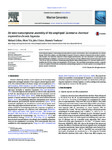De novo transcriptome assembly of the amphipod Gammarus chevreuxi exposed to chronic hypoxia
| dc.contributor.author | Collins, M | |
| dc.contributor.author | Feistel, Susanne | |
| dc.contributor.author | Spicer, John | |
| dc.contributor.author | Truebano, M | |
| dc.date.accessioned | 2018-10-24T10:22:31Z | |
| dc.date.available | 2018-10-24T10:22:31Z | |
| dc.date.issued | 2017-06 | |
| dc.identifier.issn | 1876-7478 | |
| dc.identifier.issn | 1876-7478 | |
| dc.identifier.other | C | |
| dc.identifier.uri | http://hdl.handle.net/10026.1/12610 | |
| dc.description | publisher: Elsevier articletitle: De novo transcriptome assembly of the amphipod Gammarus chevreuxi exposed to chronic hypoxia journaltitle: Marine Genomics articlelink: http://dx.doi.org/10.1016/j.margen.2017.01.006 content_type: article copyright: © 2017 Elsevier B.V. All rights reserved. | |
| dc.description.abstract |
Environmental hypoxia is becoming more prevalent in aquatic environments due to eutrophication and climate change. While the ecological and physiological responses of marine animals to hypoxia have received considerable attention, the molecular responses remain largely undetermined. We have assembled a transcriptome for the brackishwater amphipod, Gammarus chevreuxi, exposed to three different levels of environmental oxygen (100, 40 and 20% air saturation). Sequencing using Illumina HiSeq 2000 produced 227.1 M reads which were assembled into 291,934 contigs corresponding to 218,558 genes. The assembled transcriptome provides a valuable resource to explore the molecular mechanisms underpinning responses to chronic hypoxia in an ecologically-important aquatic invertebrate. | |
| dc.format.extent | 17-19 | |
| dc.language | en | |
| dc.language.iso | en | |
| dc.publisher | Elsevier | |
| dc.subject | Transcriptome | |
| dc.subject | Chronic hypoxia | |
| dc.subject | Gammarus | |
| dc.subject | Amphipod | |
| dc.title | De novo transcriptome assembly of the amphipod Gammarus chevreuxi exposed to chronic hypoxia | |
| dc.type | journal-article | |
| dc.type | Journal Article | |
| plymouth.author-url | https://www.webofscience.com/api/gateway?GWVersion=2&SrcApp=PARTNER_APP&SrcAuth=LinksAMR&KeyUT=WOS:000403737300003&DestLinkType=FullRecord&DestApp=ALL_WOS&UsrCustomerID=11bb513d99f797142bcfeffcc58ea008 | |
| plymouth.volume | 33 | |
| plymouth.publication-status | Published | |
| plymouth.journal | Marine Genomics | |
| dc.identifier.doi | 10.1016/j.margen.2017.01.006 | |
| plymouth.organisational-group | /Plymouth | |
| plymouth.organisational-group | /Plymouth/Faculty of Science and Engineering | |
| plymouth.organisational-group | /Plymouth/Faculty of Science and Engineering/School of Biological and Marine Sciences | |
| plymouth.organisational-group | /Plymouth/REF 2021 Researchers by UoA | |
| plymouth.organisational-group | /Plymouth/REF 2021 Researchers by UoA/UoA07 Earth Systems and Environmental Sciences | |
| plymouth.organisational-group | /Plymouth/Research Groups | |
| plymouth.organisational-group | /Plymouth/Research Groups/Marine Institute | |
| plymouth.organisational-group | /Plymouth/Users by role | |
| plymouth.organisational-group | /Plymouth/Users by role/Academics | |
| plymouth.organisational-group | /Plymouth/Users by role/Researchers in ResearchFish submission | |
| dcterms.dateAccepted | 2017-01-26 | |
| dc.rights.embargodate | 2018-2-8 | |
| dc.identifier.eissn | 1876-7478 | |
| dc.rights.embargoperiod | Not known | |
| rioxxterms.versionofrecord | 10.1016/j.margen.2017.01.006 | |
| rioxxterms.licenseref.uri | http://www.rioxx.net/licenses/all-rights-reserved | |
| rioxxterms.licenseref.startdate | 2017-06 | |
| rioxxterms.type | Journal Article/Review |


